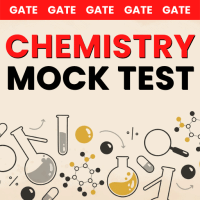Chemistry Exam > Chemistry Questions > The red colour of ruby is due to:a)d-d transi...
Start Learning for Free
The red colour of ruby is due to:
- a)d-d transition of Cr3+ ion in Cr2O3 lattice
- b)d-d transition of Cr3+ ion in Al2O3 lattice
- c)Ligand to metal charge transfer transition
- d)Metal to metal charge transfer transition
Correct answer is option 'B'. Can you explain this answer?
Most Upvoted Answer
The red colour of ruby is due to:a)d-d transition of Cr3+ ion in Cr2O3...
Explanation:
Ruby is a variety of corundum (α-Al2O3) that contains chromium (Cr3+) ions as impurities. The red color of ruby is due to the d-d transition of Cr3+ ions in Al2O3 lattice.
D-D Transition:
The d-d transition involves the excitation of an electron from one d-orbital to another d-orbital of the same metal ion. When a photon of light is absorbed, it excites an electron from the lower energy d-orbital to a higher energy d-orbital. The energy gap between the two d-orbitals corresponds to the energy of the absorbed photon. The color of the compound is determined by the energy of the absorbed photon.
Chromium in Ruby:
In ruby, chromium ions replace some of the aluminum ions in the corundum lattice. The chromium ion has a partially filled 3d orbital, which can undergo d-d transitions. When a photon of light is absorbed by a chromium ion, an electron is excited from the ground state (t2g) to the higher energy state (eg). The energy required for this transition corresponds to the red part of the visible spectrum.
Al2O3 Lattice:
The Al2O3 lattice has a distorted octahedral geometry due to the Jahn-Teller effect. The chromium ion is located at the center of the octahedron and is surrounded by six oxygen atoms. The oxygen atoms form a distorted octahedron around the chromium ion. The distortion of the octahedron causes a splitting of the d-orbitals into two different energy levels, t2g and eg. The t2g orbitals are lower in energy and are occupied by three electrons, while the eg orbitals are higher in energy and are unoccupied.
Conclusion:
The red color of ruby is due to the d-d transition of Cr3+ ions in Al2O3 lattice. When a photon of light is absorbed by a chromium ion, an electron is excited from the ground state (t2g) to the higher energy state (eg). The energy required for this transition corresponds to the red part of the visible spectrum.
Ruby is a variety of corundum (α-Al2O3) that contains chromium (Cr3+) ions as impurities. The red color of ruby is due to the d-d transition of Cr3+ ions in Al2O3 lattice.
D-D Transition:
The d-d transition involves the excitation of an electron from one d-orbital to another d-orbital of the same metal ion. When a photon of light is absorbed, it excites an electron from the lower energy d-orbital to a higher energy d-orbital. The energy gap between the two d-orbitals corresponds to the energy of the absorbed photon. The color of the compound is determined by the energy of the absorbed photon.
Chromium in Ruby:
In ruby, chromium ions replace some of the aluminum ions in the corundum lattice. The chromium ion has a partially filled 3d orbital, which can undergo d-d transitions. When a photon of light is absorbed by a chromium ion, an electron is excited from the ground state (t2g) to the higher energy state (eg). The energy required for this transition corresponds to the red part of the visible spectrum.
Al2O3 Lattice:
The Al2O3 lattice has a distorted octahedral geometry due to the Jahn-Teller effect. The chromium ion is located at the center of the octahedron and is surrounded by six oxygen atoms. The oxygen atoms form a distorted octahedron around the chromium ion. The distortion of the octahedron causes a splitting of the d-orbitals into two different energy levels, t2g and eg. The t2g orbitals are lower in energy and are occupied by three electrons, while the eg orbitals are higher in energy and are unoccupied.
Conclusion:
The red color of ruby is due to the d-d transition of Cr3+ ions in Al2O3 lattice. When a photon of light is absorbed by a chromium ion, an electron is excited from the ground state (t2g) to the higher energy state (eg). The energy required for this transition corresponds to the red part of the visible spectrum.
Free Test
FREE
| Start Free Test |
Community Answer
The red colour of ruby is due to:a)d-d transition of Cr3+ ion in Cr2O3...
When chromium replaces aluminum in corundum, the chromium atoms absorb certain wavelengths of light and reflect light in the red part of the visible light spectrum. This reflected red light is what your eyes see and gives rubies their distinctive red coloring

|
Explore Courses for Chemistry exam
|

|
Question Description
The red colour of ruby is due to:a)d-d transition of Cr3+ ion in Cr2O3 latticeb)d-d transition of Cr3+ ion in Al2O3 latticec)Ligand to metal charge transfer transitiond)Metal to metal charge transfer transitionCorrect answer is option 'B'. Can you explain this answer? for Chemistry 2025 is part of Chemistry preparation. The Question and answers have been prepared according to the Chemistry exam syllabus. Information about The red colour of ruby is due to:a)d-d transition of Cr3+ ion in Cr2O3 latticeb)d-d transition of Cr3+ ion in Al2O3 latticec)Ligand to metal charge transfer transitiond)Metal to metal charge transfer transitionCorrect answer is option 'B'. Can you explain this answer? covers all topics & solutions for Chemistry 2025 Exam. Find important definitions, questions, meanings, examples, exercises and tests below for The red colour of ruby is due to:a)d-d transition of Cr3+ ion in Cr2O3 latticeb)d-d transition of Cr3+ ion in Al2O3 latticec)Ligand to metal charge transfer transitiond)Metal to metal charge transfer transitionCorrect answer is option 'B'. Can you explain this answer?.
The red colour of ruby is due to:a)d-d transition of Cr3+ ion in Cr2O3 latticeb)d-d transition of Cr3+ ion in Al2O3 latticec)Ligand to metal charge transfer transitiond)Metal to metal charge transfer transitionCorrect answer is option 'B'. Can you explain this answer? for Chemistry 2025 is part of Chemistry preparation. The Question and answers have been prepared according to the Chemistry exam syllabus. Information about The red colour of ruby is due to:a)d-d transition of Cr3+ ion in Cr2O3 latticeb)d-d transition of Cr3+ ion in Al2O3 latticec)Ligand to metal charge transfer transitiond)Metal to metal charge transfer transitionCorrect answer is option 'B'. Can you explain this answer? covers all topics & solutions for Chemistry 2025 Exam. Find important definitions, questions, meanings, examples, exercises and tests below for The red colour of ruby is due to:a)d-d transition of Cr3+ ion in Cr2O3 latticeb)d-d transition of Cr3+ ion in Al2O3 latticec)Ligand to metal charge transfer transitiond)Metal to metal charge transfer transitionCorrect answer is option 'B'. Can you explain this answer?.
Solutions for The red colour of ruby is due to:a)d-d transition of Cr3+ ion in Cr2O3 latticeb)d-d transition of Cr3+ ion in Al2O3 latticec)Ligand to metal charge transfer transitiond)Metal to metal charge transfer transitionCorrect answer is option 'B'. Can you explain this answer? in English & in Hindi are available as part of our courses for Chemistry.
Download more important topics, notes, lectures and mock test series for Chemistry Exam by signing up for free.
Here you can find the meaning of The red colour of ruby is due to:a)d-d transition of Cr3+ ion in Cr2O3 latticeb)d-d transition of Cr3+ ion in Al2O3 latticec)Ligand to metal charge transfer transitiond)Metal to metal charge transfer transitionCorrect answer is option 'B'. Can you explain this answer? defined & explained in the simplest way possible. Besides giving the explanation of
The red colour of ruby is due to:a)d-d transition of Cr3+ ion in Cr2O3 latticeb)d-d transition of Cr3+ ion in Al2O3 latticec)Ligand to metal charge transfer transitiond)Metal to metal charge transfer transitionCorrect answer is option 'B'. Can you explain this answer?, a detailed solution for The red colour of ruby is due to:a)d-d transition of Cr3+ ion in Cr2O3 latticeb)d-d transition of Cr3+ ion in Al2O3 latticec)Ligand to metal charge transfer transitiond)Metal to metal charge transfer transitionCorrect answer is option 'B'. Can you explain this answer? has been provided alongside types of The red colour of ruby is due to:a)d-d transition of Cr3+ ion in Cr2O3 latticeb)d-d transition of Cr3+ ion in Al2O3 latticec)Ligand to metal charge transfer transitiond)Metal to metal charge transfer transitionCorrect answer is option 'B'. Can you explain this answer? theory, EduRev gives you an
ample number of questions to practice The red colour of ruby is due to:a)d-d transition of Cr3+ ion in Cr2O3 latticeb)d-d transition of Cr3+ ion in Al2O3 latticec)Ligand to metal charge transfer transitiond)Metal to metal charge transfer transitionCorrect answer is option 'B'. Can you explain this answer? tests, examples and also practice Chemistry tests.

|
Explore Courses for Chemistry exam
|

|
Signup for Free!
Signup to see your scores go up within 7 days! Learn & Practice with 1000+ FREE Notes, Videos & Tests.























